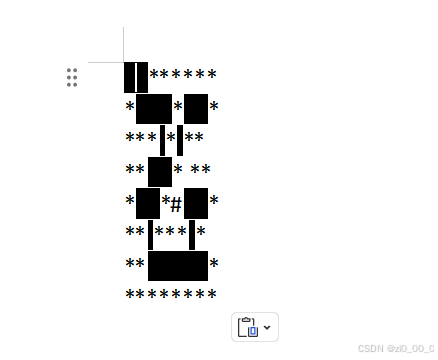【基本概念】
寻路算法
寻路的结果是根据起始点S和目标点T,找到路径Path。
寻路中通常用栅形网格简化表示地图,周围八个格子表示可以通行的方向
游戏中通常需要最快找到该路径(A*算法),而不是找到最短的路径(Dijkstra算法)
距离度量
欧式距离,即两点间直线距离的计算
曼哈顿距离,有方向限制,只能水平或垂直移动
对角距离,在曼哈顿距离基础上,允许沿着对角线移动
切比雪夫距离,有方向限制,取水平或垂直移动两者的最大值
距离因子
在栅形网格下,可以认为上下左右的距离为1,但计算对角距离时为小数,为了都采用整形计算,乘以10的因子
因此,上下左右距离为10,对角距离为14
成本/代价
常用的说法是cost,从一个点到另外一个点的成本,通常成本就是距离的度量,在机器学习中,还会加上其他因素的度量,寻路算法中只有距离度量。
启发函数
搜索最基本的思路是穷举搜索,例如广度优先和深度优先搜索,但当搜索空间过大,也即可能性太多时,最好可以提供一种方式,对可能性做筛选,减少搜索空间,进而提高搜索效率。
如果有提供筛选方法,那么就是启发式搜索,这个方法也叫启发函数。
贪心策略
通常来说,搜索是一步步进行的,每一步会将新的可能加入到待处理队列中,如果每一步都从当前可能中选择一个最优的结果,这就是贪心的。
结果舍弃
在贪心策略下,如果在当前步得到了最优结果,可以将其他结果全部舍弃,以最优结果为基础做下一步搜索时,添加新的可能并从这些可能中找到找到最优结果。
也可以不做结果舍弃,在下一步搜索时,将添加的新的可能和已有的可能合在一起找当前步的最优结构。
寻路算法不做结果舍弃。
搜索结果
有的搜索中只需要知道路径是多大,而有的搜索需要知道路径是什么,寻路中需要知道路径是什么
【寻路算法】
常见的寻路算是迪杰斯特拉算法(Dijkstra)、最佳搜索搜索算法(BFS)、A*算法。他们都遵循相似的算法过程,只在计算和更新cost时有较大区别。算法主要流程如下:
- 确定一个起始点和目标点
- 将起点加入open队列中,open队列表示需要处理的可能性,这里用Point表示
- 从open队列中取出cost最小的Point。只有起点时就是起点,随着队列中的Point变多,要排序取出最小值
- 筛选open队列的邻近的Point并加入open队列中,此时open队列逐渐膨胀,在寻路算法中不做结果舍弃
- 栅形格子邻近的Point就是周围的八个
- 这8个中有的不能通行的格子要舍去
- 已经处理过的格子要舍弃
- 已经在open队列中的格子,需要更新cost
- 不在open队列中的格子,需要计算cost,并当如open队列中
- 将此次取出来的最小的Point放入close队列中,close队列表示已经处理过的Point
- 重复3-5步骤,直到open队列为空,或者取出来的最小的Point就是目标点
Dijkstra算法
Dijkstra算法是典型最短路径算法,可以计算一个起始节点到路径中其他所有节点的最短路径。
计算cost时:Point的cost是累加的,当前筛选出来的Point的cost = 当前从open队列中取出的Point的cost + 筛选Point到取出point的cost
因为计算cost是不断累加的,因此距离起点越远的点cost越大
更新cost时: 筛选的Point可能已经在open队列中存在,这表明有多条路径可以到达该Point。因为要找出来最短路径,所以需要比较筛选出来的Point与已经存在的Point谁的cost更低,将更低的cost作为新的cost。
如果已经存在的更低,说明之前的路径更短;如果筛选的更低,说明从起点到当前选择最小的Point再到当前筛选的Point的路径是从起点到Point的最短路径
算法特点:可以看到在搜索邻近的Point时,除了可以通行的Point外,没对Point做任何筛选,因为Point的cost是累加的,距离起点越近的点cost越小,也就越可能从open队列中取出来。
如果所有的点都可以通行,被取出来的点基本就是沿着起点一圈圈往外扩散的。
随着搜索的进行,目标Point的cost可能是open队列中最小,被取出来,此时就已经找到了通向这个点的最短路径了。
时间复杂度:所有可能点都会被放入到open队列中,也会被选择出来,如果可能的点总数为N,最外层循环次数为N,内层有一个获取邻近点的循环,这里的次数为8,同时还有一个排序的计算,如果用最小堆,时间复杂度为logN,总的时间复杂度为(N+8)logN
BFS
最佳优先搜索算法中每个Point的cost是不变的,其cost是该Point到目标Point的路径cost,不需要更新cost
其特点为:每次都会选择距离目标点最近的Point,如果起始点和目标点有凹形阻挡,将会导航进入凹形内部很长时间后才出来,实际表现为角色来回转圈
A*
A*寻路算法在计算cost时即会像Dijkstra一样考虑累积路径cost,也会像BFS一样考虑到目标点的cost。其cost计算公式为:
F = G + H 。其中G表示累积路径cost,H表示到目标点的cost
计算cost时,需先按照累积路径方式计算G,H只需在首次计算一次
更新cost时,H保持不变,实际就是更新G,只有当前计算的G更小时才做更新
其特点为:此时cost表示从起点到该点的最短路径+该点到目标点的估计距离,这种计算cost的方式更为科学,能更快更好的找到接近目标点的点位,也即寻路速度更快
在游戏中,更快寻路往往更重要,通过计算合适的cost,引导点位选择是寻路算法的核心所在。
当起点和终点距离很远时,刚开始寻路,H远大于G,此时相当于按照BFS的方式寻路;邻近终点时,G远大于H,此时相当于按照Dijkstra方式寻路
【代码实现】
下文是最原始的版本实现,不足以用到实际项目中,后文针对A*看一看如何优化
public class Navigate
{public SearchType searchType;public enum SearchType{Dijkstra,BFS,AStar,}public HCostType costType = HCostType.Diagonal;public enum HCostType{Manhattan,Euclidean,Diagonal,}public static int DisFactor = 10;public static int DiagonalDisFactor = 14;public Dictionary<SearchType, ISearch> algorithm = new Dictionary<SearchType, ISearch>();public bool FindPath(int2 start, int2 target, List<int2> path){if (path == null || path.Count > 0) return false;if (!algorithm.TryGetValue(searchType, out var algo)){algorithm[searchType] = CreateSearch(searchType);}return algo.FindPath(start, target, path);}public ISearch CreateSearch(SearchType searchType){ISearch res = null;switch (searchType){case SearchType.Dijkstra: res = new Dijkstra(GetCost); break;case SearchType.BFS: res = new BFS(GetHCost); break;case SearchType.AStar: res = new AStar(GetCost, GetHCost); break;}return res;}public int GetCost(int2 cur, int2 next){if (next.x == -1 && next.y == -1){return -1;}int cost = 0;if (cur.x == next.x || cur.y == next.y){cost = DisFactor;}else{cost = DiagonalDisFactor;}return cost;}public int GetHCost(int2 pos, int2 target){int hCost = 0;if (costType == HCostType.Manhattan){hCost = Mathf.Abs(pos.x - target.x) * DisFactor + Mathf.Abs(pos.y - target.y) * DisFactor;}else if (costType == HCostType.Euclidean){hCost = (int)Mathf.Sqrt(Mathf.Pow((pos.x - target.x) * DisFactor, 2) + Mathf.Pow((pos.y - target.y) * DisFactor, 2));}else if (costType == HCostType.Diagonal){int x = Mathf.Abs(pos.x - target.x);int y = Mathf.Abs(pos.y - target.y);int a = Mathf.Min(x, y);hCost = a * DiagonalDisFactor + Mathf.Abs(x - y) * DisFactor;}return hCost;}
}public interface ISearch
{bool FindPath(int2 start, int2 target, List<int2> path);
}public class Dijkstra : ISearch
{private Dictionary<int2, Point> openDic = new Dictionary<int2, Point>();private Dictionary<int2, Point> closeDic = new Dictionary<int2, Point>();private Dictionary<int2, Point> pos2Point = new Dictionary<int2, Point>();public bool FindPath(int2 startPoint, int2 targetPoint, List<int2> path){if (path == null || path.Count > 0) return false;var start = GetOrCreatePoint(startPoint);var target = GetOrCreatePoint(targetPoint);openDic.Clear();closeDic.Clear();openDic.Add(startPoint, start);start.Reset();target.Reset();bool res = false;while (openDic.Count > 0){var point = openDic.First().Value;if (point == target){res = true;break;}//删除该点openDic.Remove(point.pos);ProcessNeighbouringPoints(point, target);//该点已被处理过closeDic.Add(point.pos, point);openDic = openDic.OrderBy(kv => kv.Value.cost).ToDictionary(p => p.Key, o => o.Value);}foreach (var point in target.path){path.Add(point.pos);}res = true;return res;}private Func<int2, int2, int> getCost;private static int2 NullPos = new int2(-1, -1);public Dijkstra(Func<int2, int2, int> getCost){this.getCost = getCost;}private Point GetOrCreatePoint(int2 pos){if (!pos2Point.TryGetValue(pos, out var point)){pos2Point[pos] = point = new Point();point.pos = pos;}return point;}private List<int2> nPoints = new List<int2>();public void ProcessNeighbouringPoints(Point point, Point target){nPoints.Clear();point.GetNeighbouringPoints(nPoints);foreach (var item in nPoints){if (closeDic.TryGetValue(item, out var npoint)){continue;}if (getCost(item, NullPos) == -1)//-1表示点不可通行{continue;}UpdateCost(point, item, target);}}public void UpdateCost(Point point, int2 pos, Point target){int cost = getCost(point.pos, pos);if (openDic.TryGetValue(pos, out var npoint)){if (cost + point.cost < npoint.cost){npoint.cost = cost + point.cost;npoint.path.Clear();npoint.path.AddRange(point.path);}}else{npoint = GetOrCreatePoint(pos);npoint.Reset();npoint.cost = cost + point.cost;npoint.path.AddRange(point.path);openDic[pos] = npoint;}}public class Point{public int2 pos;public int cost;public List<Point> path = new List<Point>();public void Reset(){path.Clear();cost = int.MaxValue;}public bool GetNeighbouringPoints(List<int2> points){if (points == null || points.Count > 0) return false;for (int i = -1; i < 2; i++){for (int j = -1; j < 2; j++){if (i == 0 && j == 0) continue;int2 newpos = new int2(pos.x + i, pos.y + j);//超出地图范围if (newpos.x < 0 || newpos.x >= MapM || newpos.y < 0 || newpos.y >= MapN)continue;points.Add(newpos);}}return true;}}
}public class BFS : ISearch
{private Dictionary<int2, Point> openDic = new Dictionary<int2, Point>();private Dictionary<int2, Point> closeDic = new Dictionary<int2, Point>();private Dictionary<int2, Point> pos2Point = new Dictionary<int2, Point>();public bool FindPath(int2 startPoint, int2 targetPoint, List<int2> path){if (path == null || path.Count > 0) return false;var start = GetOrCreatePoint(startPoint);var target = GetOrCreatePoint(targetPoint);openDic.Clear();closeDic.Clear();openDic.Add(startPoint, start);start.Reset();target.Reset();bool res = false;while (openDic.Count > 0){var point = openDic.First().Value;path.Add(point.pos);if (point == target){ res = true;break;}openDic.Remove(point.pos);ProcessNeighbouringPoints(point, target);closeDic.Add(point.pos, point);openDic = openDic.OrderBy(kv => kv.Value.cost).ToDictionary(p => p.Key, o => o.Value);}return res;}private Func<int2, int2, int> getCost;private static int2 NullPos = new int2(-1, -1);public BFS(Func<int2, int2, int> getCost){this.getCost = getCost;}private Point GetOrCreatePoint(int2 pos){if (!pos2Point.TryGetValue(pos, out var point)){pos2Point[pos] = point = new Point();point.pos = pos;}return point;}private List<int2> nPoints = new List<int2>();public void ProcessNeighbouringPoints(Point point, Point target){nPoints.Clear();point.GetNeighbouringPoints(nPoints);foreach (var item in nPoints){if (closeDic.TryGetValue(item, out var npoint)){continue;}if (getCost(item, NullPos) == -1)//-1表示点不可通行{continue;}UpdateCost(point, item, target);}}public void UpdateCost(Point point, int2 pos, Point target){int cost = getCost(target.pos, pos);if (!openDic.TryGetValue(pos, out var npoint)){npoint = GetOrCreatePoint(pos);npoint.Reset();npoint.cost = cost;openDic[pos] = npoint;}}public class Point{public int2 pos;public int cost;public void Reset(){cost = int.MaxValue;}public bool GetNeighbouringPoints(List<int2> points){if (points == null || points.Count > 0) return false;for (int i = -1; i < 2; i++){for (int j = -1; j < 2; j++){if (i == 0 && j == 0) continue;int2 newpos = new int2(pos.x + i, pos.y + j);//超出地图范围if (newpos.x < 0 || newpos.x >= MapM || newpos.y < 0 || newpos.y >= MapN)continue;points.Add(newpos);}}return true;}}
}
public class AStar : ISearch
{private Dictionary<int2, Point> openDic = new Dictionary<int2, Point>();private Dictionary<int2, Point> closeDic = new Dictionary<int2, Point>();private Dictionary<int2, Point> pos2Point = new Dictionary<int2, Point>();public bool FindPath(int2 startPoint, int2 targetPoint, List<int2> path){if (path == null || path.Count > 0) return false;var start = GetOrCreatePoint(startPoint);var target = GetOrCreatePoint(targetPoint);openDic.Clear();closeDic.Clear();openDic.Add(startPoint, start);start.Reset();target.Reset();bool res = false;while (openDic.Count > 0){var point = openDic.First().Value;path.Add(point.pos);if (point == target){res = true;break;}openDic.Remove(point.pos);ProcessNeighbouringPoints(point, target);closeDic.Add(point.pos, point);openDic = openDic.OrderBy(kv => kv.Value.F).ThenBy(kv => kv.Value.H).ToDictionary(p => p.Key, o => o.Value);}return res;}private Func<int2, int2, int> getCost;private Func<int2, int2, int> getHCost;private static int2 NullPos = new int2(-1, -1);public AStar(Func<int2, int2, int> getCost, Func<int2, int2, int> getHCost){this.getCost = getCost;this.getHCost = getHCost;}private Point GetOrCreatePoint(int2 pos){if (!pos2Point.TryGetValue(pos, out var point)){pos2Point[pos] = point = new Point();point.pos = pos;}return point;}private List<int2> nPoints = new List<int2>();public void ProcessNeighbouringPoints(Point point, Point target){nPoints.Clear();point.GetNeighbouringPoints(nPoints);foreach (var item in nPoints){if (closeDic.TryGetValue(item, out var npoint)){continue;}if (getCost(item, NullPos) == -1)//-1表示点不可通行{continue;}UpdateCost(point, item, target);}}public void UpdateCost(Point point, int2 pos, Point target){int cost = getCost(target.pos, pos);int gCost = point.G + cost;if (openDic.TryGetValue(pos, out var npoint)){if (npoint.G < gCost){npoint.G = gCost;}}else{npoint = GetOrCreatePoint(pos);npoint.G = gCost;npoint.H = getHCost(pos, target.pos);openDic[pos] = npoint;}}public class Point{public int2 pos;public int H{get => _h;set{_h = value;_f = _h + _g;}}private int _h;public int G{get => _g;set{_g = value;_h = _g + _h;}}private int _g;public int F => _f;private int _f;public void Reset(){H = 0;G = 0;}public bool GetNeighbouringPoints(List<int2> points){if (points == null || points.Count > 0) return false;for (int i = -1; i < 2; i++){for (int j = -1; j < 2; j++){if (i == 0 && j == 0) continue;int2 newpos = new int2(pos.x + i, pos.y + j);//超出地图范围if (newpos.x < 0 || newpos.x >= MapM || newpos.y < 0 || newpos.y >= MapN)continue;points.Add(newpos);}}return true;}}
}【参考】
(七)通俗易懂理解——dijkstra算法求最短路径
https://zhuanlan.zhihu.com/p/385733813











![[学习笔记] Kotlin Compose-Multiplatform](https://img-home.csdnimg.cn/images/20230724024159.png?origin_url=compose.assets%2Ftooltips.gif&pos_id=img-JR8Vi11g-1738845957167)







